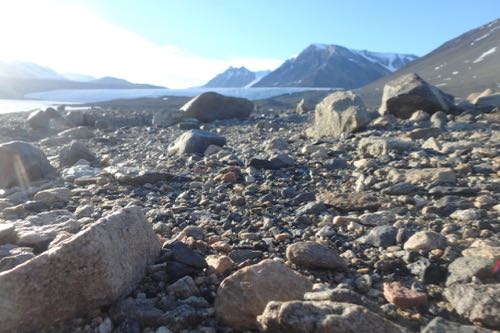Journal Entry
The Wormherders Make the Newspaper
Check out this cool article in the Daily Herald about our team.
Lake Fryxell Camp
 My tent at Lake Fryxell. Headed to bed at 1am. I love this sunshine!
My tent at Lake Fryxell. Headed to bed at 1am. I love this sunshine!
 Although I love the 24 hour sunshine, my eyes keep telling my brain to tell my body that sleep time is over and it's time to get up. I have a solution for that. I just use my neck gator to "pull down the shades". Sleep comes very easy.
Although I love the 24 hour sunshine, my eyes keep telling my brain to tell my body that sleep time is over and it's time to get up. I have a solution for that. I just use my neck gator to "pull down the shades". Sleep comes very easy.
 Our daily commute from Lake Fryxell Camp to Many Glaciers Pond. It is a beautiful 3-mile hike through this sandy, boulder covered land.
Our daily commute from Lake Fryxell Camp to Many Glaciers Pond. It is a beautiful 3-mile hike through this sandy, boulder covered land.
 Hiking terrain near Lake Fryxell Camp. Canada Glacier in background.
Hiking terrain near Lake Fryxell Camp. Canada Glacier in background.
Return to Many Glaciers Pond for 3rd and Final Day of our P3 Experiment
 Many Glaciers Pond, where we conducted our P3 experiment.
Many Glaciers Pond, where we conducted our P3 experiment.
 We added more water on our 3rd and final day here at the site of our P3 experiment. The black water barrel in the background is where pumped water from the pond is put before we let gravity bring it down the blue hose, through the blue box (which is our UV sterilizer) so it can soak through our plot.
We added more water on our 3rd and final day here at the site of our P3 experiment. The black water barrel in the background is where pumped water from the pond is put before we let gravity bring it down the blue hose, through the blue box (which is our UV sterilizer) so it can soak through our plot.
 Our final view of the P3 plot at Many Glaciers Pond before hiking out. Notice the white boxes which are soil data collection devices, and if you look close, you will see two trail cams. They will be left through the long harsh winter. The winds coming off the ice sheet above this valley can reach over 100 miles per hour.
Our final view of the P3 plot at Many Glaciers Pond before hiking out. Notice the white boxes which are soil data collection devices, and if you look close, you will see two trail cams. They will be left through the long harsh winter. The winds coming off the ice sheet above this valley can reach over 100 miles per hour.
This was about the 5th year of this experiment. Dr. Barratt mentioned that so far they are not really seeing any difference in soil animal populations between the "Pulse" (which is the drastic water treatment), "Press" (constant extra water), or the control. Upon arrival at this location, our team collected this year's samples, as described in yesterday's journal. Those samples will be taken back to the Crary Lab back in McMurdo (known as MacTown), to see if any difference will be observed for this season.
 Another view of Many Glaciers Pond. In the background is the huge Canada Glacier. Although it looks so close, it is about 3 miles away. Our camp is located near the base of the Canada Glacier.
Another view of Many Glaciers Pond. In the background is the huge Canada Glacier. Although it looks so close, it is about 3 miles away. Our camp is located near the base of the Canada Glacier.
 I found this dead skua near Many Glacier Ponds while on a short hike. These are very aggressive birds. They are predatory birds known for eating other birds. They are about the size of Sea Gulls. Due to the cold, dry environment, it's hard to tell how long ago this bird had died. It could have been weeks, or years ago.
I found this dead skua near Many Glacier Ponds while on a short hike. These are very aggressive birds. They are predatory birds known for eating other birds. They are about the size of Sea Gulls. Due to the cold, dry environment, it's hard to tell how long ago this bird had died. It could have been weeks, or years ago.
 We found this seal on our hike back to camp. We are so many miles from the ocean. This had to be such a painful thing for this seal to slither up through all these boulders. Some scientists feel that these seal mummies might be thousands of years old.
We found this seal on our hike back to camp. We are so many miles from the ocean. This had to be such a painful thing for this seal to slither up through all these boulders. Some scientists feel that these seal mummies might be thousands of years old.

Add new comment